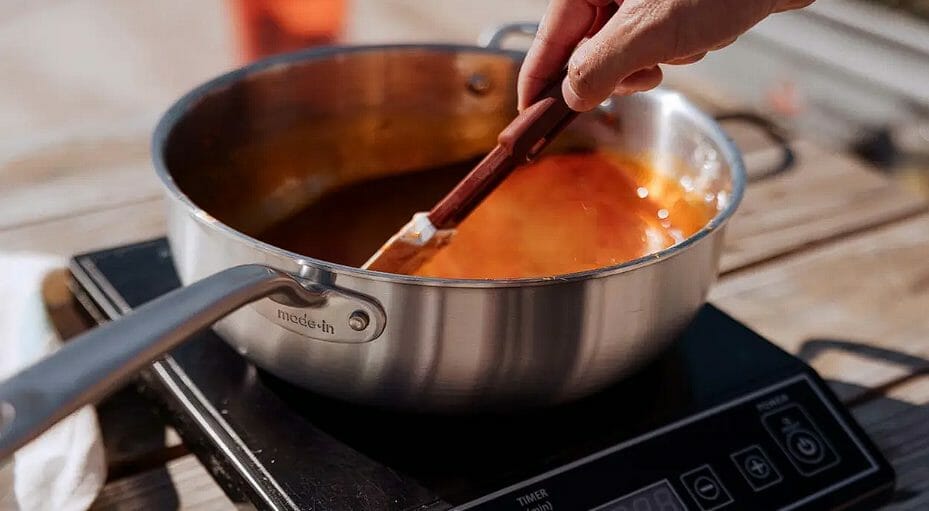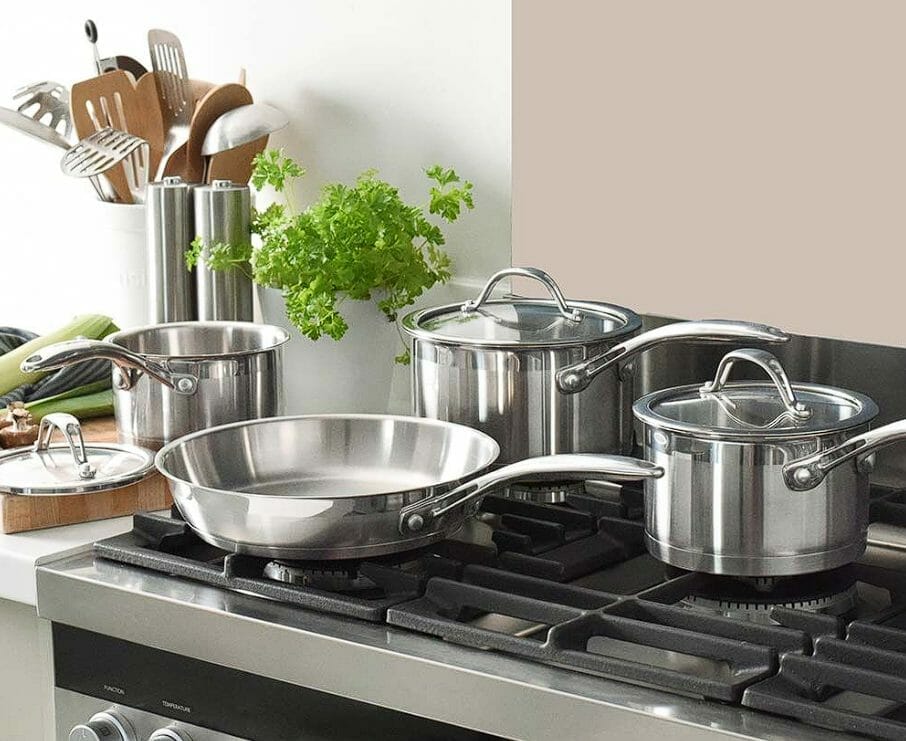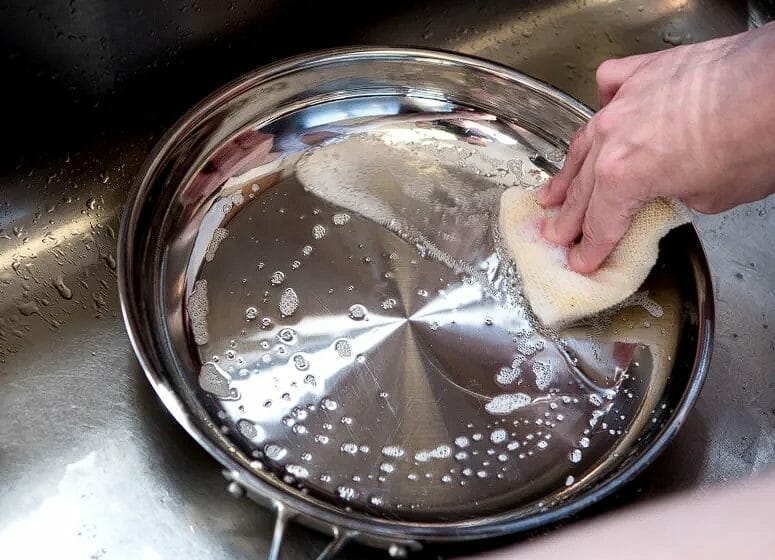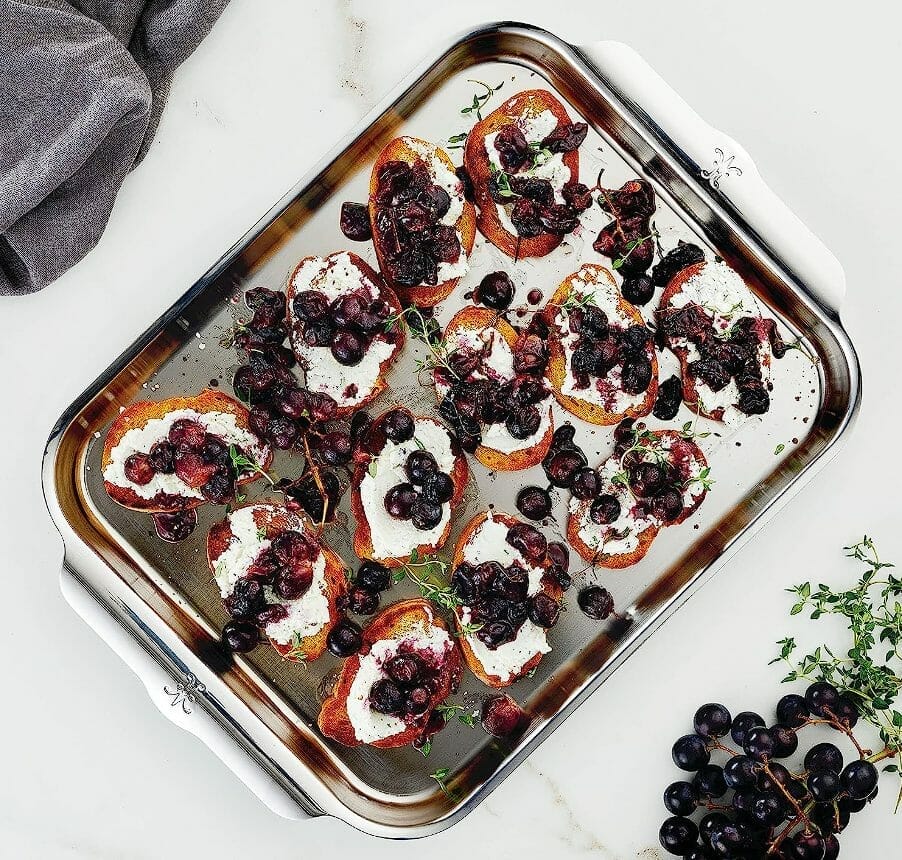When it comes to cooking, stainless steel cookware is a popular choice due to its durability and versatility. But can 18/10 stainless steel go in the oven? This is a common question for many home cooks who want to prepare a wide range of dishes. In this article, we will explore the heat resistance properties of 18/10 stainless steel and provide oven safety guidelines for using this type of cookware.
Key Takeaways:
- 18/10 stainless steel cookware can be safely used in the oven
- It is important to follow oven safety guidelines and take necessary precautions like monitoring temperature and ensuring proper handling
- Stainless steel cookware is durable and versatile, making it a great option for oven cooking
Understanding 18/10 Stainless Steel
When it comes to choosing cookware, 18/10 stainless steel is a popular option. But what exactly does this mean? Well, the numbers refer to the composition of the steel. The “18” represents the percentage of chromium, while the “10” represents the percentage of nickel. Chromium is what gives stainless steel its corrosion-resistant properties, while nickel adds to its shine and durability.
Compared to other stainless steel alloys, 18/10 stainless steel is considered high-quality because of its higher nickel content. In fact, it’s sometimes referred to as “surgical grade” stainless steel due to its use in medical equipment. The added nickel makes the steel more resistant to corrosion and staining, and also gives it a bright, polished finish.
When it comes to cookware, the high nickel content in 18/10 stainless steel is especially important. This is because acidic foods (like tomato sauce or citrus) can sometimes react with stainless steel and cause discoloration, but the added nickel helps to prevent this.
The Heat Resistance of 18/10 Stainless Steel

When it comes to using stainless steel cookware in the oven, one crucial factor to consider is its heat resistance. Luckily, 18/10 stainless steel is a durable and heat-resistant material that is suitable for oven use.
Stainless steel is graded based on its composition and quality, with 18/10 being a common grade for cookware. This grade refers to the percentage of chromium (18%) and nickel (10%) in the stainless steel composition.
The nickel content is particularly important when it comes to heat resistance, as it allows the stainless steel to withstand higher temperatures without warping or degrading. This makes 18/10 stainless steel suitable for use in the oven.
However, it is important to note that each stainless steel grade has its own specific heat resistance limits. While 18/10 stainless steel can generally withstand temperatures up to 500 degrees Fahrenheit, it is best to check the manufacturer’s guidelines for your specific cookware.
If you plan to cook at very high temperatures or for extended periods, it may be worth investing in cookware with a higher heat resistance rating. But for most home cooks, 18/10 stainless steel is a reliable and safe choice for oven use.
Oven Safety Guidelines for Stainless Steel Cookware

When using stainless steel cookware in the oven, it is crucial to follow certain safety guidelines to prevent any accidents and ensure optimal cooking results. Here are some tips to keep in mind:
- Check the temperature limits: Before placing your stainless steel cookware in the oven, ensure that it is rated for the oven temperature you plan to use. Exceeding the temperature limits of your cookware can cause damage and compromise your safety.
- Avoid extreme temperature changes: Do not place your stainless steel cookware directly from the freezer into a hot oven or vice versa. Extreme temperature changes can cause warping or cracking of the cookware.
- Use appropriate oven mitts: When handling hot stainless steel cookware, wear oven mitts that can withstand high temperatures. Avoid using wet towels or potholders that can cause burns.
- Properly position the cookware: Ensure that your stainless steel cookware is placed in the center of the oven and not too close to the walls or heating elements. This will ensure even cooking and prevent any accidental burns.
- Avoid overheating: Keep an eye on your cookware and ensure that it is not overheating. Overheating can cause damage to the cookware and release harmful fumes.
By following these guidelines, you can ensure a safe and enjoyable cooking experience with your stainless steel cookware in the oven. Remember to always prioritize safety and take precautions to avoid any accidents.
Using 18/10 Stainless Steel Pots and Pans in the Oven

If you’re wondering whether both your stainless steel pots and pans can go in the oven, the answer is yes! 18/10 stainless steel cookware, including both pots and pans, is generally oven-safe. However, it’s important to make sure that your particular set of cookware can withstand the oven temperature you plan to use.
Before placing your stainless steel pots or pans in the oven, check to ensure that they do not have any plastic or wooden handles or knobs, as these are not oven-safe and may melt or catch fire. Additionally, make sure that the cookware is free from any residue or food particles that could burn or smoke during the cooking process.
When placing your stainless steel pots or pans in the oven, be sure to use oven mitts or pot holders to protect your hands from the hot surfaces. It’s also important to place the cookware on a stable, flat surface in the oven to prevent spills or accidents.
Overall, 18/10 stainless steel cookware is a versatile and durable option for oven cooking. Whether you’re roasting vegetables or baking a cake, your stainless steel pots and pans can provide even heat distribution and easy cleanup after the meal is finished.
Benefits of Using 18/10 Stainless Steel Cookware in the Oven

Using 18/10 stainless steel cookware in the oven can provide a range of benefits for your cooking experience. Not only is this type of cookware durable and long-lasting, but it also offers excellent heat distribution and retention, making it perfect for oven cooking.
One of the key advantages of using 18/10 stainless steel cookware in the oven is its versatility. Whether you’re roasting vegetables or baking a cake, stainless steel can handle a wide range of temperatures and cooking styles.
Additionally, stainless steel cookware is easy to clean and maintain, making it a great choice for home cooks who want to spend more time cooking and less time cleaning up. Simply rinse the cookware with warm water and a mild soap, and avoid using abrasive cleaners that can scratch the surface.
Another benefit of using stainless steel cookware in the oven is its durability. Unlike other materials that can chip or crack over time, stainless steel is resistant to corrosion and wear, ensuring that your cookware will last for years to come. Plus, its non-reactive surface means that it won’t affect the flavor or quality of your food.
Overall, whether you’re a seasoned chef or a home cook, using 18/10 stainless steel cookware in the oven is a smart choice. With its durability, versatility, and excellent cooking properties, it can help you create delicious meals with ease.
Precautions When Using 18/10 Stainless Steel in the Oven

While 18/10 stainless steel cookware is generally safe for use in the oven, it’s important to take necessary precautions to avoid accidents in the kitchen. Here are some oven safety guidelines to keep in mind:
Avoid Overheating
It’s important to avoid overheating your 18/10 stainless steel cookware in the oven. Overheating can cause warping or damage to the cookware, making it unsafe for future use. Make sure to always monitor the temperature of your oven and adhere to the manufacturer’s recommended temperature limits for your cookware.
Handle with Care
When taking your 18/10 stainless steel cookware out of the oven, be sure to use oven mitts or pot holders to protect your hands. The handles of the cookware can become hot during the cooking process, so take care to avoid burns or other injuries.
Avoid Abrasive Cleaners
After using your 18/10 stainless steel cookware in the oven, it’s important to clean it thoroughly to remove any leftover residue. However, avoid using abrasive cleaners or scrubbers as they can scratch the surface of the cookware and reduce its heat resistance properties.
Proper Storage
When storing your 18/10 stainless steel cookware, be sure to stack it carefully to avoid scratches or damage. If storing it in a cabinet or drawer, use a soft cloth or paper towel to separate the pieces and prevent them from rubbing against each other.
By following these precautions, you can enjoy safe and successful oven cooking with your 18/10 stainless steel cookware.
Can Other Types of Stainless Steel Cookware Go in the Oven?
While 18/10 stainless steel cookware is generally safe for oven use, other types of stainless steel may not be suitable. The composition of the steel and the finishing process can affect its heat resistance properties, so it’s important to check the manufacturer’s recommendations before using any stainless steel cookware in the oven.
Some stainless steel grades that are commonly used for cookware include 18/0, 18/8, and 18/10. 18/0 stainless steel contains no nickel and is more prone to rust and corrosion. 18/8 stainless steel has a lower nickel content than 18/10, but is still considered food-grade material and is a popular choice for cookware.

When it comes to oven compatibility, 18/8 stainless steel is generally safe for use at temperatures up to 500°F. However, it’s always important to check the manufacturer’s instructions for specific temperature limits and safety guidelines.
18/0 stainless steel cookware may not be suitable for oven use due to its lower nickel content and poorer heat-resistance properties. It may warp, corrode, or even melt when exposed to high oven temperatures.
If you have a different type of stainless steel cookware and you’re unsure whether it’s oven-safe, it’s best to err on the side of caution and avoid putting it in the oven.
Alternative Oven-Safe Cookware Materials
If you’re looking for oven-safe cookware alternatives, there are many materials to choose from. Cast iron is a popular option due to its durability and high heat resistance. Copper cookware is also a great choice for oven cooking because it heats up quickly and is ideal for precise temperature control.
Ceramic cookware is another alternative, but it’s important to check the manufacturer’s instructions for temperature limits. Ceramic cookware can crack or break when exposed to sudden temperature changes, such as placing it from the oven directly into cold water.
When choosing alternative oven-safe cookware materials, be sure to consider the cooking method, type of food, and personal preferences.
Alternative Oven-Safe Cookware Materials

If you’re looking for alternative cookware materials that are oven-safe, there are several options to consider. Copper is a popular choice due to its excellent heat conductivity, allowing for even heating throughout the cookware. However, copper can be expensive and requires regular polishing to maintain its shine.
Another option is cast iron, which can withstand high oven temperatures and distribute heat evenly. Cast iron cookware is also durable and can last for generations with proper care. However, cast iron can be heavy and requires seasoning to prevent rusting.
You may also consider ceramic cookware, which is oven-safe and provides a non-stick surface for easy cleaning. However, ceramic cookware can be fragile and may chip or crack if not handled carefully.
Ultimately, the choice of alternative oven-safe cookware materials will depend on personal preference and cooking needs. It’s important to research and consider the pros and cons of each option before making a purchase.
Cleaning and Maintenance of 18/10 Stainless Steel Cookware

Keeping your 18/10 stainless steel cookware clean and well-maintained after oven use is vital to maintaining its quality and longevity. Here are some tips and guidelines to follow when cleaning and maintaining your cookware:
- Clean regularly: To prevent any residue from building up, it is important to clean your cookware after each use. Allow your cookware to cool down first before cleaning to prevent warping or discoloration.
- Use the right cleaning agents: Avoid using harsh detergents or abrasive sponges as they can leave scratches or damage the cookware’s surface. Instead, use mild dish soap and a soft sponge or cloth.
- Remove oven residue: If there is any residue left from oven use, mix baking soda and water to form a paste and apply it to the affected areas. Let it sit for a few minutes before gently scrubbing it off with a non-abrasive sponge or cloth.
- Dry thoroughly: After cleaning, make sure to dry your cookware thoroughly to prevent any water stains or discoloration. You can air-dry it or use a soft cloth to dry it manually.
- Store properly: Store your cookware in a dry and cool area to prevent any corrosion or discoloration. Avoid stacking your cookware to prevent scratches or damages.
Following these simple cleaning and maintenance practices can ensure that your 18/10 stainless steel cookware remains in top condition and lasts for many years to come.
Best Practices for Using 18/10 Stainless Steel in the Oven

When using 18/10 stainless steel cookware in the oven, it is important to follow some best practices to ensure a safe and successful cooking experience. Here are some tips:
1. Temperature Control
It is important to monitor the temperature of your oven when cooking with stainless steel cookware. Avoid preheating your oven to higher temperatures than recommended by the manufacturer. If you need to increase the temperature during cooking, do so gradually and in small increments.
2. Proper Handling
Always use oven mitts or potholders when handling hot stainless steel cookware. Avoid touching the hot handles with bare hands as they can easily cause burns. Also, never place hot cookware on a surface that is not heat-resistant.
3. Avoid Abrasive Cleaners
When cleaning your 18/10 stainless steel cookware after oven use, avoid using abrasive cleaners or scouring pads as they can scratch the surface. Instead, use a gentle cleaner and soft sponge or cloth to remove any residue.
4. Don’t Overcrowd the Oven
Avoid overcrowding the oven with too many items as it can affect the airflow and temperature distribution, leading to uneven cooking. Allow enough space between the items to ensure proper heat circulation.
5. Use the Right Size
Make sure to use the right size of cookware for your oven. Over-sized cookware can obstruct the airflow in the oven, while undersized cookware can lead to uneven cooking and potentially cause spills or burns.
By following these best practices, you can ensure safe and successful oven cooking with your 18/10 stainless steel cookware.
Conclusion
In conclusion, it’s safe to say that 18/10 stainless steel cookware can go in the oven, with appropriate precautions of course. It’s important to ensure that the cookware is made from high-quality stainless steel, with a stable metal composition that ensures resistance to heat.
When using 18/10 stainless steel cookware in the oven, it’s important to adhere to oven safety guidelines, such as knowing the temperature limits and taking care not to overheat the cookware. Additionally, proper handling and temperature control techniques are essential for avoiding burns and other accidents.
Overall, 18/10 stainless steel cookware is a fantastic choice for oven cooking, due to its excellent heat resistance and durability. With proper care and maintenance, it can last for years and provide a wide range of benefits. So, go ahead and use your favorite pots and pans in the oven with confidence!
Read More : Can Stainless Steel Bowls Go in the Oven? Find Out Here!
Is 10 Gauge Stainless Steel Wire Suitable for Oven Use?
10 Gauge stainless steel wire is often considered the best quality stainless steel wire for various purposes. However, when it comes to oven use, it may not be the most suitable option. Using a thicker gauge wire, such as 8 or 6 gauge, is advisable to ensure better heat resistance and durability in high-temperature settings.
Can I Use Brazing Techniques to Join Stainless Steel for Oven Use?
Yes, brazing techniques can be used to join stainless steel for oven use. The high temperatures involved in oven applications make brazing an effective method for creating strong and durable stainless steel joints. With the right materials and expertise in join stainless steel techniques, you can ensure a reliable bond that can withstand the heat and conditions inside the oven.
FAQ
Q: Can 18/10 stainless steel go in the oven?
A: Yes, 18/10 stainless steel cookware is generally safe for oven use.
Q: What is 18/10 stainless steel?
A: 18/10 stainless steel refers to the composition of the cookware, with 18% chromium and 10% nickel.
Q: What is the heat resistance of 18/10 stainless steel?
A: 18/10 stainless steel can withstand high oven temperatures, typically up to 500°F (260°C).
Q: Are there any safety guidelines for using stainless steel cookware in the oven?
A: Yes, it is important to follow temperature limits and handle the cookware with oven mitts or pot holders.
Q: Can both pots and pans made of 18/10 stainless steel be used in the oven?
A: Yes, both pots and pans made of 18/10 stainless steel can safely go in the oven.
Q: What are the benefits of using 18/10 stainless steel cookware in the oven?
A: 18/10 stainless steel cookware is known for its durability, versatility, and even heat distribution.
Q: What precautions should I take when using 18/10 stainless steel cookware in the oven?
A: Avoid overheating the cookware and always use oven mitts or pot holders when handling hot pans.
Q: Can other types of stainless steel cookware be used in the oven?
A: The oven compatibility of other stainless steel types may vary, so it’s best to check the manufacturer’s instructions.
Q: What are some alternative oven-safe cookware materials?
A: Copper and cast iron are popular alternative materials that are safe for oven use.
Q: How do I clean and maintain 18/10 stainless steel cookware after oven use?
A: Use mild dish soap, warm water, and a non-abrasive sponge to clean the cookware. Avoid using harsh chemicals or abrasive cleaners.
Q: What are some best practices for using 18/10 stainless steel in the oven?
A: Proper temperature control, preheating the oven, and allowing the cookware to cool before cleaning are all important best practices.






